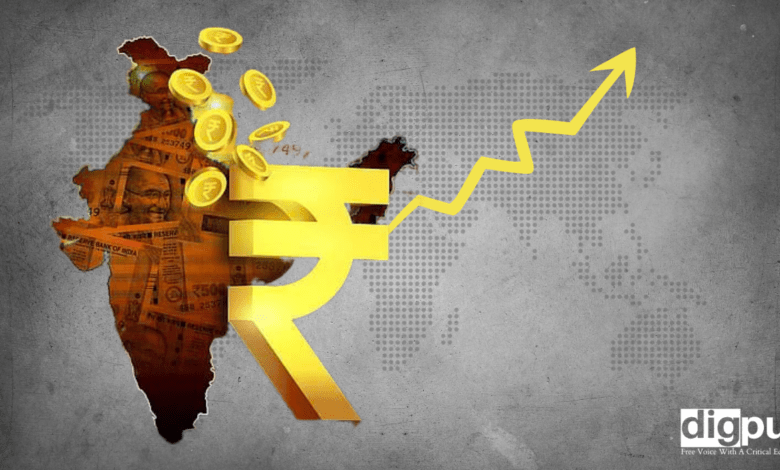Indian Economy Surpasses $4 Trillion GDP: A Landmark for the Fastest-Growing Economy in World
In this comprehensive exploration, we delve into India's historic economic achievement, crossing the $4 trillion GDP mark for the first time. From the journey to this milestone and its implications for India and the world, to the challenges ahead and the nation's promising future, we uncover the multifaceted story of India's economic ascent.

In a historic feat, Indian economy has achieved an unprecedented milestone by surpassing the $4 trillion mark for the first time in its history. This accomplishment solidifies India’s status as the fastest-growing major economy globally, highlighting its extraordinary economic evolution over recent decades.
The Journey to $4 Trillion
India’s remarkable GDP growth is attributed to a confluence of factors, each playing a pivotal role in propelling the nation to this historic milestone. One of the fundamental drivers has been India’s burgeoning and youthful population. With over 600 million people under the age of 25, the country boasts a demographic advantage, contributing significantly to its economic vitality. This young and dynamic workforce has been a catalyst for innovation, productivity, and growth across various sectors.
Furthermore, the strategic emphasis on education and skill development has ensured that this demographic dividend is harnessed effectively. A skilled workforce has been a cornerstone of India’s economic success, especially in sectors such as information technology, pharmaceuticals, and telecommunications. These industries have not only flourished domestically but have also positioned India as a global leader in various technological and scientific domains.
In addition to demographic factors, rapid urbanization has been a key driver of economic expansion. Urban centers have become hubs of economic activity, fostering innovation, entrepreneurship, and connectivity. The government’s focus on infrastructure development has played a crucial role in improving connectivity across the country, linking urban and rural areas and facilitating the movement of goods and services.
Equally instrumental in India’s economic trajectory has been the series of economic reforms undertaken to liberalize markets and attract foreign investment. These reforms have created a more conducive environment for businesses to thrive, fostering competition and innovation. The opening up of sectors such as manufacturing, finance, and retail has not only invited domestic investment but has also attracted foreign direct investment, contributing to the overall growth trajectory.
Key Sectors Driving Growth
Several sectors have been at the forefront of India’s economic surge. Information technology, often hailed as the backbone of the Indian economy, has experienced remarkable growth, providing employment opportunities and contributing significantly to exports. The pharmaceutical industry, known for its innovation and generic drug production, has not only catered to domestic healthcare needs but has also emerged as a major player in the global pharmaceutical market.
Telecommunications is another sector that has witnessed transformative growth, with widespread access to mobile phones and the internet. The digital revolution has not only connected people across the vast landscape of India but has also facilitated the growth of e-commerce and digital services.
Infrastructure development has been a priority, and significant strides have been made in areas such as roads, railways, and ports. This focus on infrastructure has not only enhanced connectivity but has also boosted productivity and efficiency, laying the foundation for sustained economic growth.
Implications for India and the World
The crossing of the $4 trillion GDP threshold holds profound implications for both India and the global community. For India, this milestone serves as a confidence booster, poised to accelerate economic growth. The confidence stemming from this achievement is expected to attract further investment, both domestic and international, creating new avenues for businesses and individuals alike.
Moreover, the economic growth is anticipated to have a positive impact on living standards. As income levels rise and opportunities expand, there is potential for a significant improvement in the quality of life for a substantial portion of the population. This, in turn, can contribute to social development, education, and healthcare, fostering a more inclusive and equitable society.
On the global stage, India’s burgeoning economy presents a substantial opportunity for international trade and investment. As one of the world’s fastest-growing major economies, India is increasingly becoming an attractive destination for foreign investors. The country’s economic influence is not limited to its borders; it is playing an increasingly important role in global affairs.
India’s rising influence is particularly notable in areas such as climate change and international development. As a major player, India’s commitment to sustainable practices and its efforts in addressing global challenges contribute significantly to shaping the global agenda. The country’s economic strength positions it as a key partner in international collaborations aimed at addressing issues of global significance.
Challenges on the Horizon
While celebrating this economic milestone, it’s crucial to acknowledge the challenges that India still faces. Persistent issues such as poverty, inequality, and environmental degradation require sustained attention and targeted policies. The government’s commitment to inclusive growth will be tested as it seeks to ensure that the benefits of economic prosperity reach all segments of society.
Addressing poverty and inequality involves not only economic measures but also social interventions. Investments in education and healthcare are imperative to equip the workforce with the skills needed for a rapidly evolving economy. Additionally, healthcare investments contribute to the overall well-being of the population, creating a healthy and productive workforce.
Environmental degradation is another critical challenge that cannot be ignored. As India continues to experience rapid urbanization and industrialization, sustainable practices become paramount. Balancing economic growth with environmental stewardship is a delicate task that necessitates thoughtful policies and responsible corporate practices.
Looking Ahead: A Bright Future
Despite the challenges, India’s economic trajectory points towards a bright future. The nation has the potential to become one of the world’s leading economies, with projections suggesting a GDP of $10 trillion by 2030. This ambitious target requires a continued commitment to economic reforms, sustainable development, and social inclusion.
India’s success is not merely a statistical achievement but a symbol of the nation’s remarkable transformation. From a predominantly agrarian economy to a global economic player, the journey reflects the hard work and resilience of the Indian people. It is also a testament to the bold decisions made by policymakers to unleash India’s economic potential.
As India continues on this trajectory, it has the opportunity to not only enhance the lives of its citizens but also play a more substantial role in shaping the global economy. The interconnectedness of the world today means that India’s economic strength contributes not only to its own prosperity but also to the stability and growth of the global economic landscape.
Facts and Figures
- India’s GDP is anticipated to grow at a rate of around 7% in 2023, solidifying its position as the fastest-growing major economy globally.
- Home to one of the world’s largest and rapidly expanding middle classes, India is witnessing a transformative demographic shift.
- With over 600 million people under the age of 25, India boasts a youthful and skilled workforce.
- A global powerhouse in exports, India leads in IT services, pharmaceuticals, and textiles.
- As the world’s third-largest consumer of electricity, India’s energy demands underscore its economic vibrancy.
India’s achievement of a $4 trillion GDP is a momentous occasion, symbolising the nation’s incredible metamorphosis and its potential to emerge as a formidable global economic force. As India continues to navigate its economic journey, addressing challenges and embracing opportunities, it stands at the threshold of a future characterised by sustained growth, inclusive development, and global influence.







